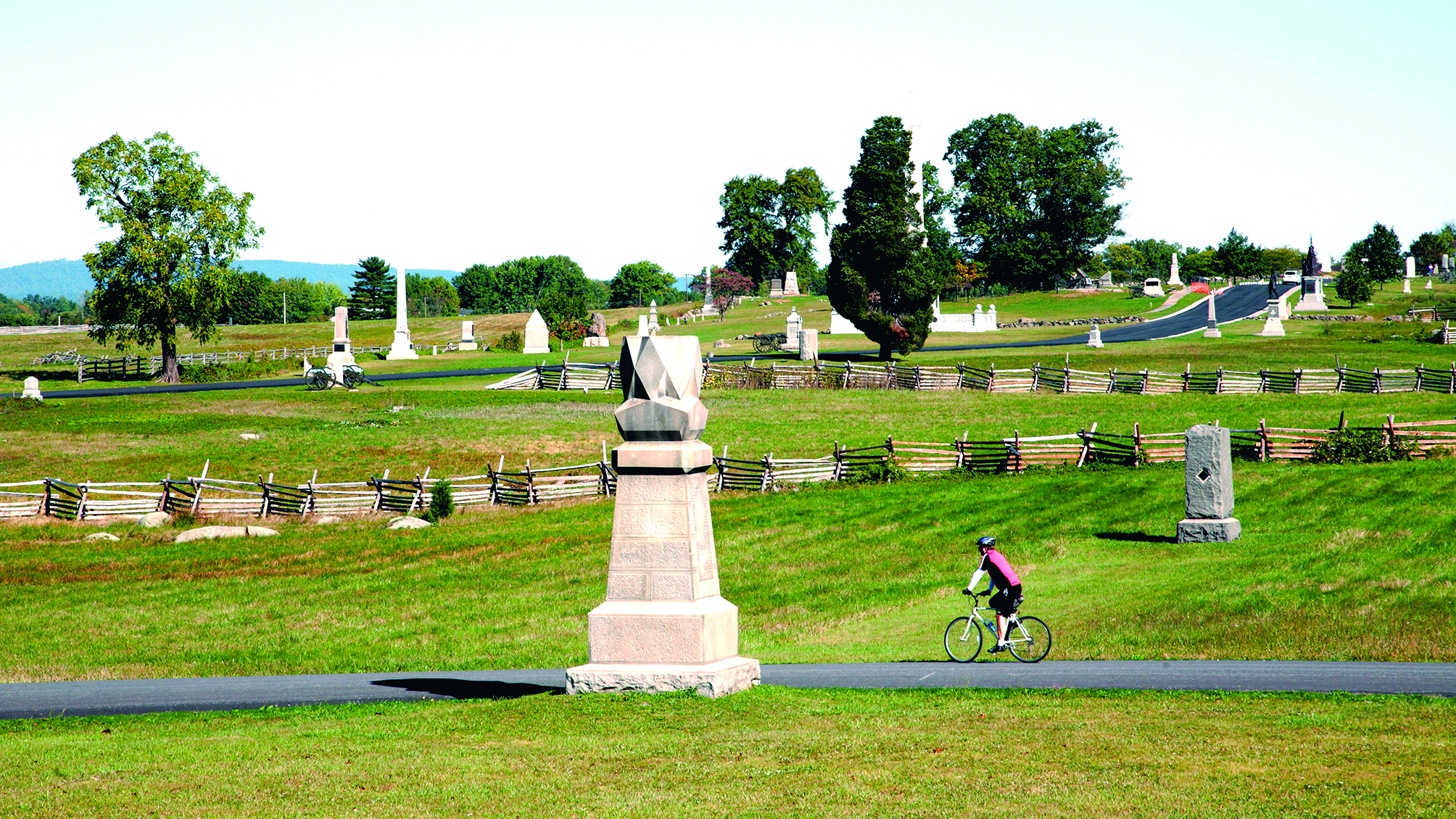Battlefield guide is a must for any cyclist’s daypack
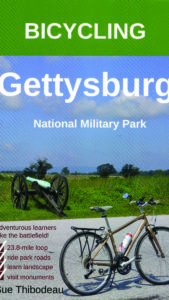
By Sue Thibodeau
Civil War Cycling, 2019, $37
Whether you’re a cycling enthusiast, history buff, or both, Sue Thibodeau’s Bicycling Gettysburg National Military Park: The Cyclist’s Civil War Travel Guide is a must-have for your next visit to Gettysburg. In fact, this 286-page book is so chock-full of useful maps, photographs, and reference information about the battlefield’s monuments,farm buildings, and areas of interest that it should be in the daypack of anybody touring the park and/or town of Gettysburg. Thibodeau, a cyclist and former teacher, has compiled a series of bicycle routes, complete with maps and turn-by-turn directions, that can be completed in a full day ride around the battlefield, or broken up into segments for shorter rides. The varied maps offer any cyclist an opportunity to follow a route, no matter their skill level. Her detailed course instructions include realistic cautions about hills and terrain, and helpful time estimates with or without stops for sightseeing. The book itself includes the maps for the full day loop. Companion maps for 12 smaller routes can be purchased separately online in PDF format for nominal fees. After following the book’s Culp’s Hill course on a balmy Saturday morning in May, I’m sold that there may be no better way to tour the battlefield than on two wheels. The opportunity to cruise past the landscape’s open fields, rocky hills, and woodlots, while easily hopping on and off bike for frequent stops to read monuments or signage or to snap photographs, is incomparable. Anybody looking to do the same could only enhance their experience through the use of Thibodeau’s informative battlefield guide.—Reviewed by Melissa A. Winn
[hr]
Cranky Rebel
Familiar nicknames for many Confederate generals sprang from readily discernible origins. Nathan G. “Shanks” Evans reportedly had remarkably skinny legs as a West Point cadet. Everyone knows about the genesis of Thomas J. Jackson’s renowned nom de guerre. Some others are not so obvious. Why, for instance, was General H.H. Walker of Virginia known as “Mud”?
William Edmondson “Grumble” Jones belongs to the transparent-nicknames group, having earned the designation through decades of steadily un-sunny demeanor. He deserved the “Grumble” label, beyond question. A dreadful marital disaster in 1852 surely must have exacerbated Jones’ naturally dour worldview. As Jones returned to his Texas posting that March with his wife of only a few weeks, Eliza “Pink” Dunn, their ship sank off Matagorda Island and Mrs. Jones drowned.
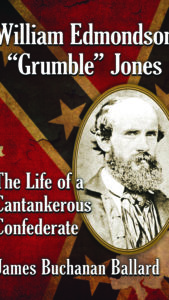
By James Buchanan Ballard
McFarland & Co., 2019, $39.95
The apogee of Jones’ Grumbleness involved dealings with J.E.B. Stuart. Both men came from southwestern Virginia and both attended Emory & Henry College before West Point. That propinquity produced absolutely no common ground. Each hated the other cordially and did not hesitate to say so. Perhaps the animus that grew so virulent originated in their Old Army duty stations in Texas, where in 1854-55 they twice replaced one another as lieutenants in a cavalry company at a dreary frontier post. It ripened into open conflict in 1862, when Stuart, younger by nearly a decade, commanded a brigade in which Jones served as colonel. Unfortunately, Ballard did not use the riches of the National Archives to explore the extensive prewar manuscripts, nor the war-date correspondence files of the military establishment.
Ballard did, though, unearth a great deal of other important original material about Jones, and sketched his interesting career capably. He often cites the only prior major work on Jones, by Dobbie E. Lambert in 1992, but adds numerous fresh sources.
After the Stuart imbroglio, Jones spent much of the war leading cavalry in the Shenandoah Valley. Stonewall Jackson, who had been friendly with Jones at West Point, steadily recommended him for promotions and assignments, including to Jackson’s old Valley command. He declared Jones better qualified for cavalry command than “any other field officer.” R.E. Lee, who clearly recognized the drawbacks inherent in Jones’ style, urged rejection of his attempted resignation and called him a “brave & intelligent officer.”
The contemporary record makes it clear that Jones’ strong prejudices led him to behave improperly at times, but it also affords plenty of evidence that Grumble performed extremely capably as a cavalry leader, including at times on a large stage. By the time an enemy bullet killed Jones at Piedmont in June 1864, he had carved out an admirable record in the field. The dark cloud that hovered over his personality ought not to obscure that fact.
This solid book stands strong against the annoying modern trend in Civil War publishing, which produces a cascade of thin books on battles and leaders that include absolutely nothing new. Ballard’s Grumble unveils new information, carefully developed, on an important topic.—Reviewed by Robert K. Krick
[hr]
Meade on His Own
This is the second volume in a three-part series on the Civil War in Virginia from the conclusion of the Gettysburg Campaign until the end of active operations in December 1863.
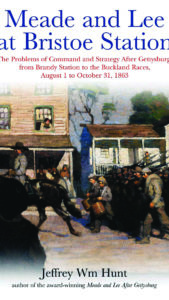
By Jeffrey W. Hunt
Savas Beatie, 2019, $34.95
The first volume in the series, “Meade and Lee After Gettysburg,” examines the period July 14-28, 1863, between the Army of Northern Virginia’s retreat across the Potomac River and its arrival behind the upper Rappahannock River. This volume, based on extensive research in both published and unpublished sources, looks at the period that followed, August–October, as Robert E. Lee and George Gordon Meade dueled for the upper hand. That maneuvering concluded with the Bristoe Station Campaign.
Author Jeffrey Hunt makes a substantial contribution to understanding what Presidents Jefferson Davis and Abraham Lincoln were attempting to accomplish by providing fresh insight that helps us understand the strategies of the campaign. The author does an excellent job showing that Lee tried to reclaim the initiative that he lost at Gettysburg. This treatment’s clarity of organization and accuracy of description, coupled with interpretive insights, enable the reader to grasp both details and the larger picture of Meade and his only period in command not under the gaze of Ulysses S. Grant. This is mandatory reading for anyone interested in this seldom discussed period. —Reviewed by David Marshall
[hr]
The past is never dead
Nina Silber, a history professor at Boston University, states that this book represents her “attempt to understand how Americans across the social, political, and economic spectrum found a ‘usable past’ in the U.S. Civil War in the 1930s and ’40s….” To accomplish this, Silber seeks an answer to “Why do Americans return to the Civil War again and again for artistic inspiration, emotional solace, political understanding, and moral counsel?”
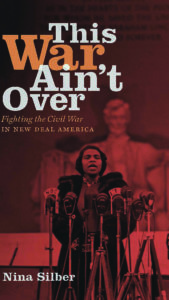
By Nina Silber
UNC Press, 2018, $32.95
During Franklin Roosevelt’s presidency, the United States experienced years of economic depression followed by years of global war. Americans looked to their history to understand how previous generations weathered similar upheavals. The Civil War came closest. Silber recognizes that different groups remolded stories of that conflict in different ways, depending on their political, social, racial, and cultural experiences, primarily around the memory of slavery, emancipation, Abraham Lincoln, and the Lost Cause. Silber recognizes that, over time, these forms of remembrance “were less tethered to events and emotions of the 1860s and far more to the concerns, sensibilities, and structural imperatives of 20th-century life.”
In the Depression-era South, poor whites “tended to cast themselves as the ‘slaves’ who suffered, both historically, and in the present day under the weight of Yankee oppression.” Their efforts to find economic and social purchase led many Southern whites to opt for the Lost Cause narrative that “resurrected the demand for ‘states’ rights,’ celebrated Confederate heroism, and repudiated various New Deal and politically liberal policies—especially pertaining to race.”
African Americans pushed back against this manipulation of memory “to suggest a level of exploitation that was shaped by a long historical legacy of racial injustice….” All sides co-opted Lincoln’s memory to suit their purposes and the 16th president underwent a series of depictions ranging from a purveyor of federal power and racial justice to “a singular representative of Americans’ rebuke to global dictatorship.” William Faulkner presciently wrote “the past is never dead, it’s not even past.” Silber understands Faulkner’s insight, noting that “when white supremacists and neo-Nazis rally to preserve old monuments to a lost cause, the signs are abundant of the Civil War’s enormous, even devastating, political and cultural power.” —Reviewed by Gordon Berg
[hr]
Colonel Holmes at Kennesaw
Garth D. Bishop and Mark A. Smith have produced a real treat for students of the Atlanta Campaign by sharing the memoir of Bishop’s ancestor, James T. Holmes, in Movements and Positions in the Battle of Kennesaw Mountain: The Memoir of Colonel James T. Holmes, 52d Ohio Volunteer Infantry. The colonel’s text presents a vivid account of the struggle at the Dead Angle at Kennesaw Mountain. Holmes, who had already written a full memoir of his military service, felt compelled to recount the fight from the day of the battle through the Confederate withdrawal, after the Illinois Monument at the Dead Angle, dedicated in 1915, was placed on the ground held by his 52nd Ohio.
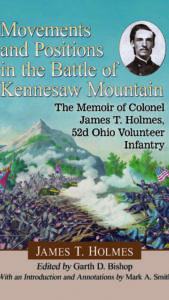
Garth D. Bishop and Mark A. Smith, editors
McFarland & Co., 2018, $29.95
Holmes provides two detailed chapters about the June 27 assault related to the actions of Colonel Dan McCook’s brigade. Holmes describes the chaos of the failed assault and how the men immediately began to dig in within only a few yards of the Confederate works. He then contends that the 52nd Ohio held its position until after the Confederate evacuation of the position. Holmes is a vivid narrator, and a number of micro maps show the positions of his regiment and nearby units from the attack to where they ended up in the repulse.
Bishop helps the reader along by drawing from Holmes’ earlier memoir, Then and Now, as well as other writings by Holmes, including a program for a 52nd Ohio reunion. It is somewhat puzzling, therefore, why the editors did not incorporate the whole memoir into a published work. As it stands Movements and Positions is only 151 pages long, and although very valuable for its insight into the Battle of Kennesaw Mountain, a publication of the entire Colonel Holmes story would be of greater value. Still, for students of the Atlanta Campaign, historical memory, and the Battle of Kennesaw Mountain in particular, I highly recommend this memoir.—Reviewed by Lee White
[hr]
Restless Men
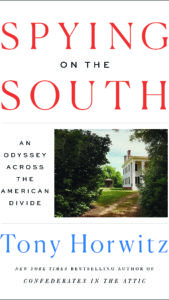
By Tony Horwitz
Penguin Press, 2019, $30
Frederick Law Olmsted is best known for his landscape architecture, primarily New York City’s Central Park, where metropolitan cacophony gives way to birdsong. But few realize Olmsted’s urban oasis had its roots in journeys south on the eve of the Civil War. Olmsted was a restless young Northern man, not unlike U.S. Grant or Abe Lincoln, knocked loose by the transforming economy into searching for his life’s work. He went to school. He went to sea. He went to the barnyard. But those didn’t fulfill. So, he took up a pen and notebook and became a reporter. In 1852 and 1854, he traveled through the American south by stagecoach, riverboat, and horseback, exploring a land of slavery few north of the Mason-Dixon line understood. Although “Fred,” as he was known, never really came to accept or like what he saw, he colorfully documented the exotic land of plantations.
Tony Horwitz was also a restless writer, a man who spent much of his life tracing historical paths to try and understand the present. In Spying on the South, in my opinion Horwitz’s best book since Confederates in the Attic, he follows Olmsted’s footsteps as closely as possible, seamlessly weaving back and forth from the 1850s to current day as he talks to barge deckhands, state legislators, and barstool acquaintances during his own quest to understand the current mindset of the former Confederacy.
Though separated by decades, both writers found a very different place from the coastal megalopolis where so many Americans have resided. While Olmsted probed the region, one of enormous wealth built on the backs of enslaved workers, he was also forced to confront inequities in the North. Central Park, designed to be equally accessible to everyone, was the first of many efforts by Olmsted to contribute to a leveling of society. His egalitarian beliefs also inspired him to serve as the head of the U.S. Sanitary Commission during the Civil War. In that role, he not only personally treated wounded soldiers, but also helped to develop a series of procedures and protocols that highly enhanced the commission’s operations.
On Horwitz’s travels in the South, he found a region with improved race relations and wealth distribution, but he also traveled through areas where people felt bypassed and overlooked by society’s rapid changes.
Olmsted’s journey, and Horwitz’s retracing of it, helps us understand how Americans stopped listening to each other and launched into patriotic gore, invoking the conflict that provided Civil War reenactors so many hallowed battlefields to interpret. We should heed the lessons taught by these restless men. Horwitz didn’t design a park, but he did leave this book, which is available and also accessible to everyone. Get it. Read it. And let its thoughtful passages help silence the clamor of today’s divisive media and give way to a more harmonized understanding of the issues that separate 21st-century Americans.—Reviewed by Dana B. Shoaf
[hr]
A Long Journey
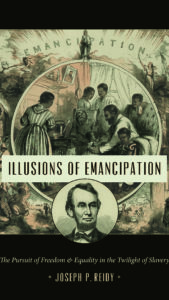
By Joseph P. Reidy
UNC Press, 2019, $32.95
“Freedom for themselves” is a phrase more and more common in the modern historiography of emancipation and the struggle for freedom waged by formerly enslaved African Americans during the Civil War and the turbulent years of Reconstruction that followed. Historians like Joseph Reidy have recognized the active role played by enslaved people in seizing the initiative for securing their own freedom rather than being merely the passive recipients of emancipation.
Reidy begins his comprehensive analysis of the journey from slavery to freedom “with the simple assertion that emancipation was a complex and uneven process rather than a specific event, and that it drew into its vortex as historical actors from all regions of the country and backgrounds, most significantly enslaved Southerners and free African Americans in the North as well as the South.”
Reidy chooses “three overlapping frameworks whereby members of the Civil War generation attempted to both understand and to help chart a way through the extraordinary events that swirled about them daily.” The frameworks are time, space, and a reference point he identifies as “home.” This methodology allows Reidy to emphasize “the testimony of formerly enslaved people in understanding wartime emancipation.”
This innovative approach can make Reidy’s book slow going until one becomes adept at understanding how he uses each term. Time, for Reidy, can be chronologically linear such as the passage of laws or the arrival of Union forces; seasonal time focuses on the weather or the agricultural cycle of planting and harvesting; and he understands erratic or revolutionary time as something new created by the war where long historical cycles are crowded into a single year.
For a slave seeking freedom, space could mean “a vast and varied geography, and one that, owing to the disruptive nature of the war, continued to shift right through the summer of 1865.” Or space could be as intimate as a plantation kitchen or humble slave cabin. How each slave experienced the myriad contingencies associated with time and space helped determine his or her individual experience on the road to emancipation and freedom.
Explaining the complex and changing concept of home is Reidy’s most insightful historiographic contribution. He demonstrates that establishing a new home was much more than a physical endeavor for newly freed people. It involved establishing a distinct identity in relation to the new political, economic, and social order. Reidy concludes that the search for a new home is both a literal place in which to dwell peacefully and a figurative community where all live as equals. “That challenge,” he laments, “long outlasted the Civil War era.”—Reviewed by Gordon Berg
[hr]
North Carolina Guidebook
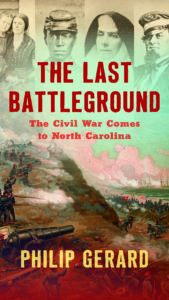
By Philip Gerard
UNC Press, 2019, $28
The Last Battleground is Civil War “lite.” Written by a nonexpert, intended for a general audience. The 43 brief chapters, unencumbered by footnotes, originally appeared in Our State magazine. They are written in the present tense and not intended to be a detailed, chronological accounting of the war in North Carolina. Rather, each is a stand-alone vignette devoted to “personal tales of people making the hardest choices of their lives.”
Gerard’s scholarship is remarkably sound. Two distinguished historians of the Civil War in North Carolina—Mark Bradley and Chris Fonvielle Jr.—contributed their professional expertise, and Gerard’s selected sources include many authoritative accounts. His modus operandi is to bring events to the reader through the eyes of the participants. This narrative strategy allows Gerard to give a sense of personal immediacy to events that otherwise might be lost in a litany of names, numbers, dates, and places. The “you are there” methodology should make the information more accessible to a general audience or to young readers just starting out on a journey through the Civil War.—Reviewed by Gordon Berg

